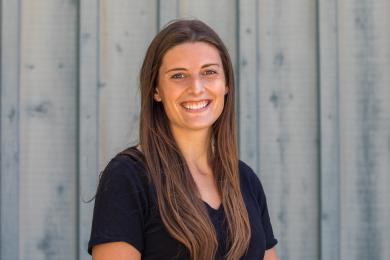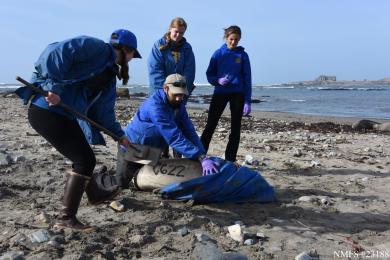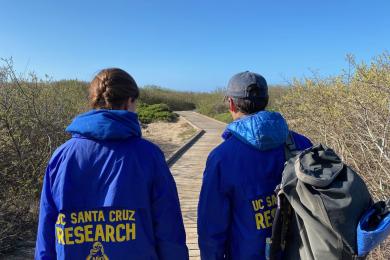Roxanne is a UCSC alumna who went on to complete her PhD at the University of Alaska Fairbanks in 2018. Her dissertation research was on Weddell seals and she traveled to Antarctica seven times for her work! There she visited McMurdo Station located on Ross Island which serves as a United States research facility operated by the National Science Foundation. She feels lucky to have been able to travel there and experience events that few people will ever have the opportunity to do.
Roxanne’s current research includes tracking young-of-the-year elephant seals during their initial trips to the sea and tracking adult females during their post-molt migrations. She frequently collaborates with Daniel Costa, distinguished Professor of Ecology and Evolutionary Biology at UCSC. One of their research projects was using electronic tags to track the movements and behavior of elephant seals relative to the risks imposed by their predators. She has won numerous awards and received several grants both as a student, a postdoctoral researcher and now, as a faculty member.
This past June, Roxanne was awarded a $600,000 grant by The Arnold and Mabel Beckman Foundation as part of its Beckman Young Investigator Program. With this grant, Roxanne and her team plan to develop and implement a novel acoustic recorder for eavesdropping on the ocean soundscape to monitor the acoustic environment of northern elephant seals which spend seven months of the year swimming back and forth from California to the middle of the North Pacific Ocean.
For over 20 years, scientists have used bio loggers (instruments for GPS tracking, video, audio, etc.) glued to animals to study their behavior, movements and even how fat they get when they are out in the ocean during foraging migrations. Nevertheless, it remains a mystery what these animals really experience out in the open ocean. Scientists have a very limited idea of the sensory experience of animals because the technology for detecting the sensory inputs (sound and visuals) have lagged. By using elephant seals as a mobile sensor platform, Roxanne will explore previously unstudied open ocean and down to the “twilight zone,” the areas just beyond the reach of sunlight.
With the data that she gets back she will not only be able to tell what the elephant seals hear but also to potentially detect and identify the calls into different types of animals that are producing the sounds. There are many marine animals that are not accessible because they are so cryptic and they dive deep into places that are not accessible. Consider the example of Beaked whales, the diving champions of marine mammals. They inhabit the middle of the ocean and can dive very deep, holding their breath for nearly 3 hours. Because of that, they are among the species we know the least about. Acoustic signals recorded with the help of elephant seals in the open ocean will enable researchers to determine which species of whales are present. Whales make different types of sounds, like clicks and buzzes. The various types of calls can be quantified to figure out exactly what the whales are doing in those places and therefore get a better understanding of the ocean ecosystem.
A key requirement for the project is to develop a durable high-capacity acoustic recorder with the necessary features (seal proof, water proof, longer duration recordings, and a stronger housing to withstand the extreme pressure of the deep ocean). Roxanne is collaborating with an acoustics expert at Cornell University, Holger Klinck, to build the devices. The $10,000 cost of the recorders, with instrumentation, is high compared to the electronic tags she has used in the past. The researchers plan to attach them to 8 adult female elephant seals per year for three years beginning in February 2022.
Roxanne noted that anytime the researchers put an instrument on a seal that is migrating 10,000 kilometers (over 6,000 miles) and going a mile deep, they worry that the tag could fail. She will work with her team to make the most “seal proof” recorders possible!
The project will be executed in our beloved Año Nuevo Island Reserve on the San Mateo coast, one of the Parks CSPA supports. The reserve is one of 39 wildland sites in the University of California Natural Reserve System. You can follow their Facebook page to learn more about the research on elephant seals and updates on Roxanne’s progress.
In 2017, Roxanne wrote a children’s book titled “A Seal Named Patches,” co-created with Dr. Patrick Robinson, Director of Año Nuevo Reserve. The book is targeted to young children (ages 5-7) who could be motivated to follow the path of scientific adventurers to study marine life and protect the wonders of nature.
About two years ago, Roxanne gave a talk at TEDx Santa Cruz, “How learning in nature helps diverse students succeed”. She believes that the researchers’ fieldwork provides an ideal outdoor classroom for the next generation of biologists. Students learn best via hands-on experiences, especially when interacting with professors and collaborating with peers.
The San Mateo coast is honored to be contributing to important scientific research due to the skills and effort of Roxanne Beltran. Here are a few resources for you to learn more about her work:
- Año Nuevo Research page on Facebook
- Beltran Lab at UC Santa Cruz
- TEDx Santa Cruz talk from December 2019
- University of Alaska Press Fairbanks - Children’s book “A Seal Named Patches”
- Building a Better Fieldwork Future, a field training program at UC Santa Cruz
- Learning to swim, elephant seal style, Natural Reserve System, UC



